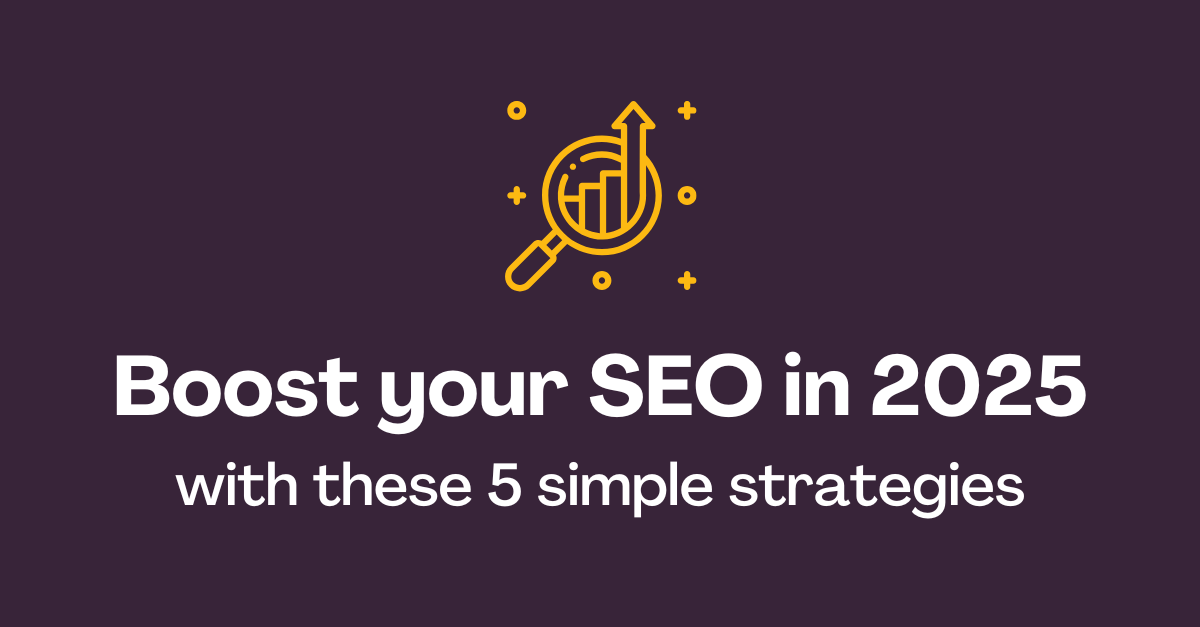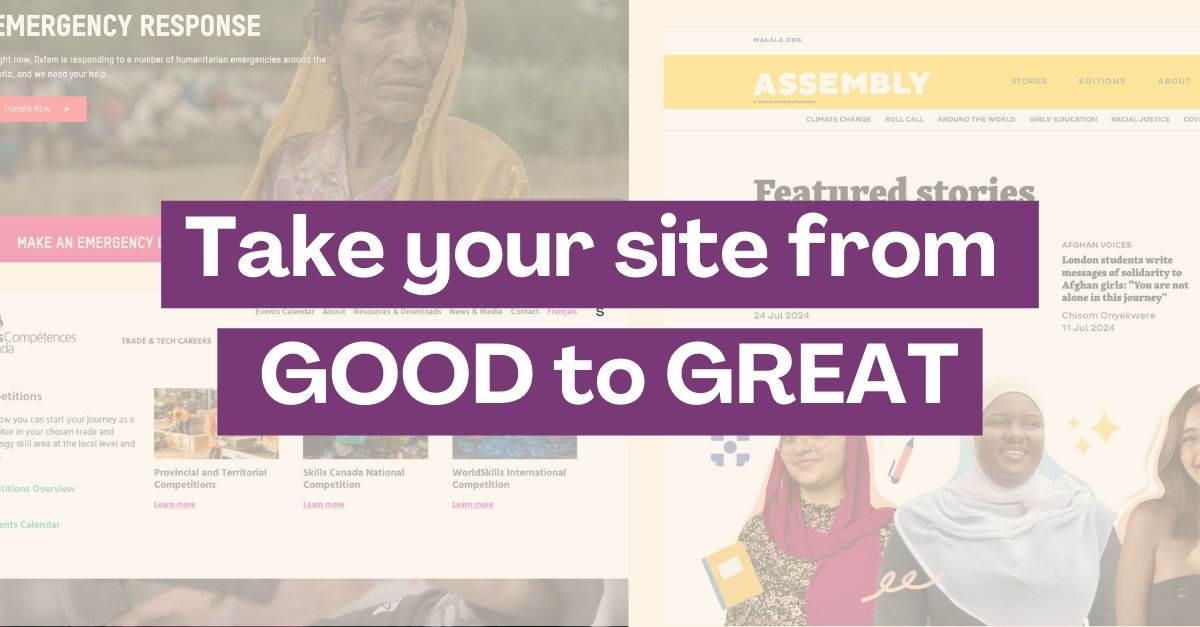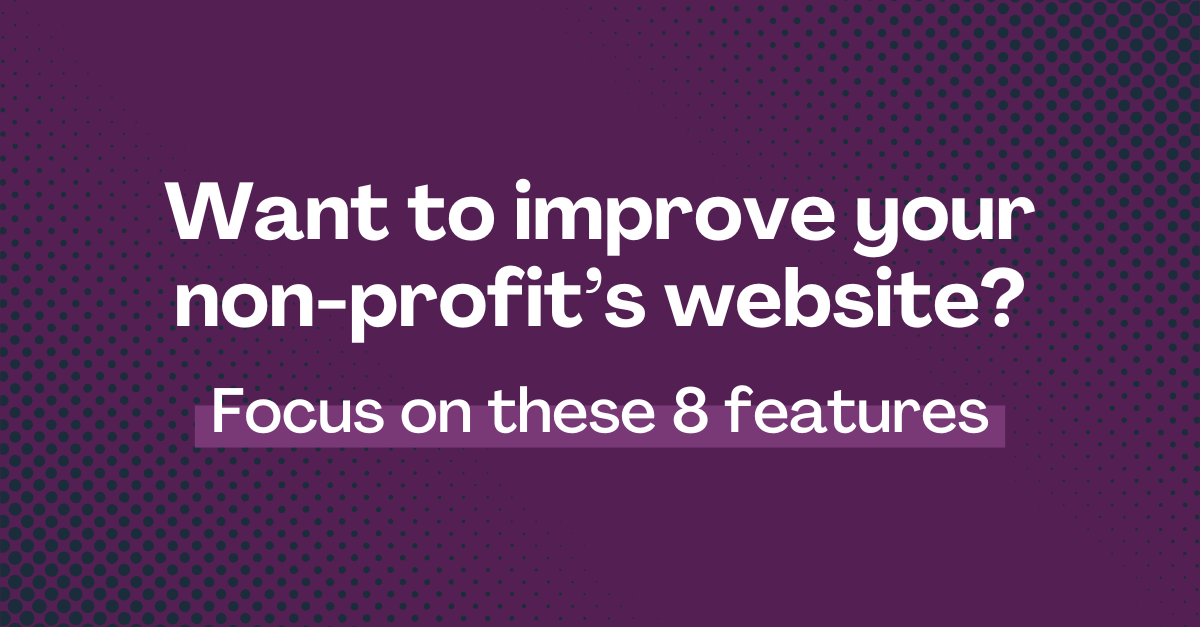Persuasion in digital marketing: what you need to know
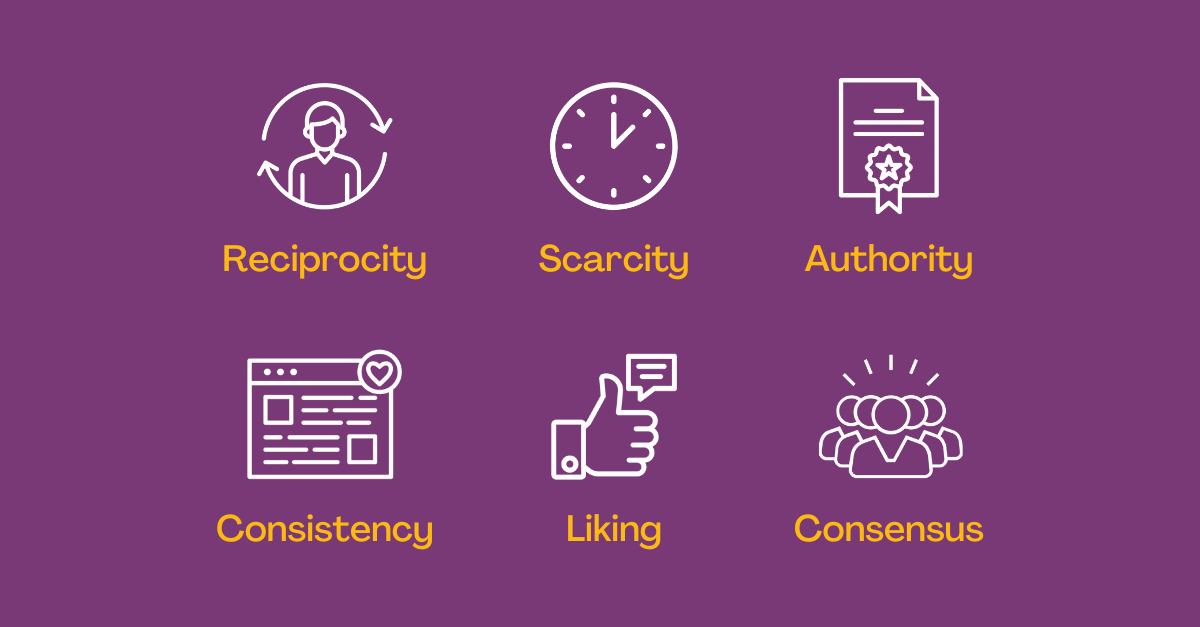
Digital Psychology has become quite the trendy topic over the last few years. People are spending so much of their time online, making decisions, conducting business, and spending their money digitally. As we navigate the ever-evolving digital space, scientists are researching how people can leverage traditional psychology theories and apply them to countless platforms and online tools.
Despite it still being a newish concept, there are all sorts of digital psychology courses you can take online. I personally loved getting my certification in digital psychology from AlterSpark, a week-long in-person class held by Brian Cugelman, PhD, a behavioural scientist from Toronto. Information that was once only available to larger companies has become accessible and tailored to all types of businesses wanting to promote their services online.
SMBs and marketers are always looking for tactics and ways to improve their online presence, increase conversions, reach a wider audience, or just get noticed. And with thousands of people all doing the same thing, it can be extremely difficult to find a way to stand out.
What are the six principles of persuasion?
Back in 1984, Robert Cialdini, a Stanford University professor and one of the behavioural scientists hired for Obama’s 2002 presidential campaign, believed that there were six core principles that persuaded people to make decisions and form opinions. Popular among pop psychologists and marketers alike, his theory is still taught and implemented to this day. Now, 35+ years later, these tactics have been backed by solid research and science, and have proven to stand the test of time.
1. Reciprocity: We are obliged to give if we have been given something first.
When you sign up for free trials, use a discount code, receive a small gift or sample when buying something, or when you enter contests and giveaways, you are being persuaded to reciprocate; most people will want to return the favour if you give them something first. How does this work? If you quickly provide value to a person, or if you are the first company to do so, they naturally feel indebted and are thus more likely to buy what you’re selling.

(source)
Standing behind a cult following, Sephora has exclusivity on a ton of high-end beauty products and gives you points for buying their products. The higher level you go (the more you buy), the more you receive. The gamification of their online shopping experience stimulates your dopamine receptors (the pleasure and likeability receptors of your brain) the same way using a drug or kissing someone would; it instils a positive feeling from the consumer. The consumer is “gifted” great quality samples that they get to choose, and Sephora gets loyal consumers who keep coming back.
2. Scarcity: If there’s not a lot of it, we want it more.
You’ll often see this used online for bigger ticket items like TVs and plane tickets; you are told to “act fast” or else you’ll lose the opportunity, you’ll see a timer counting down and lots of “limited time offers”. Sales that only last 24 hours and limited quantities of items are all tactics to influence the consumer to want it more than they normally would. Scarcity works through anticipated regret, where we imagine our future self regretting not having done something sooner. Scarcity works best when it’s experienced for the first time. When people see the same thing on sale a few days in a row, they are less interested in purchasing it.
Expedia, and all other travel companies, use this principle quite often (some might argue a little too often). Letting the user know there is only 1 ticket left at that price and time they requested pressures the consumer to make a decision now so that they don’t miss out and regret it later.

You’ll also see popular travel sites use the following language to get you to “convert” (AKA make a purchase):
- “You missed it! We reserved our last available room at this property.”
- “Our availability in London is low on your dates – lock in a great price before it’s too late.”
- “9 other people are looking right now.”
- “Hurry! Only 2 rooms left on these dates.”

Boost your online presence with our help
- Web design and development
- SEO and PPC
- Social media strategy
- AI technology
3. Authority: We are more likely to comply with a request if it is coming from a perceived authority or expert.
Endorsement deals, influencers, celebrity appearances, or even the Prime Minister telling you to do something has an impact on your decision-making. There is a reason why companies pay big money to have someone of influence represent their brand. If someone of higher perceived status likes something, then we think it must be good. A critical part of this tactic is that the consumer or user must believe that the person is authoritative to be persuaded by them. This is why commercials use doctors in lab coats, brands use celebrities to promote their products, and why Instagram is full of influencers – they’re all trying to sell us something.
I remember when cable TV was full of infomercials with celebrity endorsements – and with over a decade of ads behind them, ProActiv is one brand notorious for using this strategy. In 2019, they signed an endorsement deal with Kendall Jenner, a well-recognized household name in the market they were trying to reach: young Gen Zs suffering from acne.
Using such a popular influencer allowed them to reach a completely new audience without sounding like an infomercial or an ad, thus generating millions in sales. Thanks to Kendall, who like other young adults, candidly spoke out about her battle with acne, ProActiv was able to reach an audience that both related to and looked up to her. Kendall is seen as an authority figure in their eyes, and ProActiv benefited directly by using this principle of influence.
4. Consistency: We want to be consistent with our past commitments, even if the initial commitment is much smaller.
Humans have the deep need to be seen as consistent, especially if a commitment was made in public. We want to be seen as nice people, and we often align our self-image with commitment. One example of commitment is a company giving away free samples (a small commitment) so that the customer is more inclined to come back and purchase the full size after using them. Another popular strategy is for websites to give away a free whitepaper download that is designed to feel like a purchase so that the customer is more likely to come back and buy something later. An important factor is that the consumer must feel like the commitment aligns with their values and that they are not being coerced. They must believe that this is a personal choice.
Neil Patel is a popular author and influencer in the marketing world. He offers a free website analysis tool and a ton of marketing resources that any new marketer would find useful. When you land on his website, the first thing you see is his free website analysis tool. All you have to do is enter your URL:
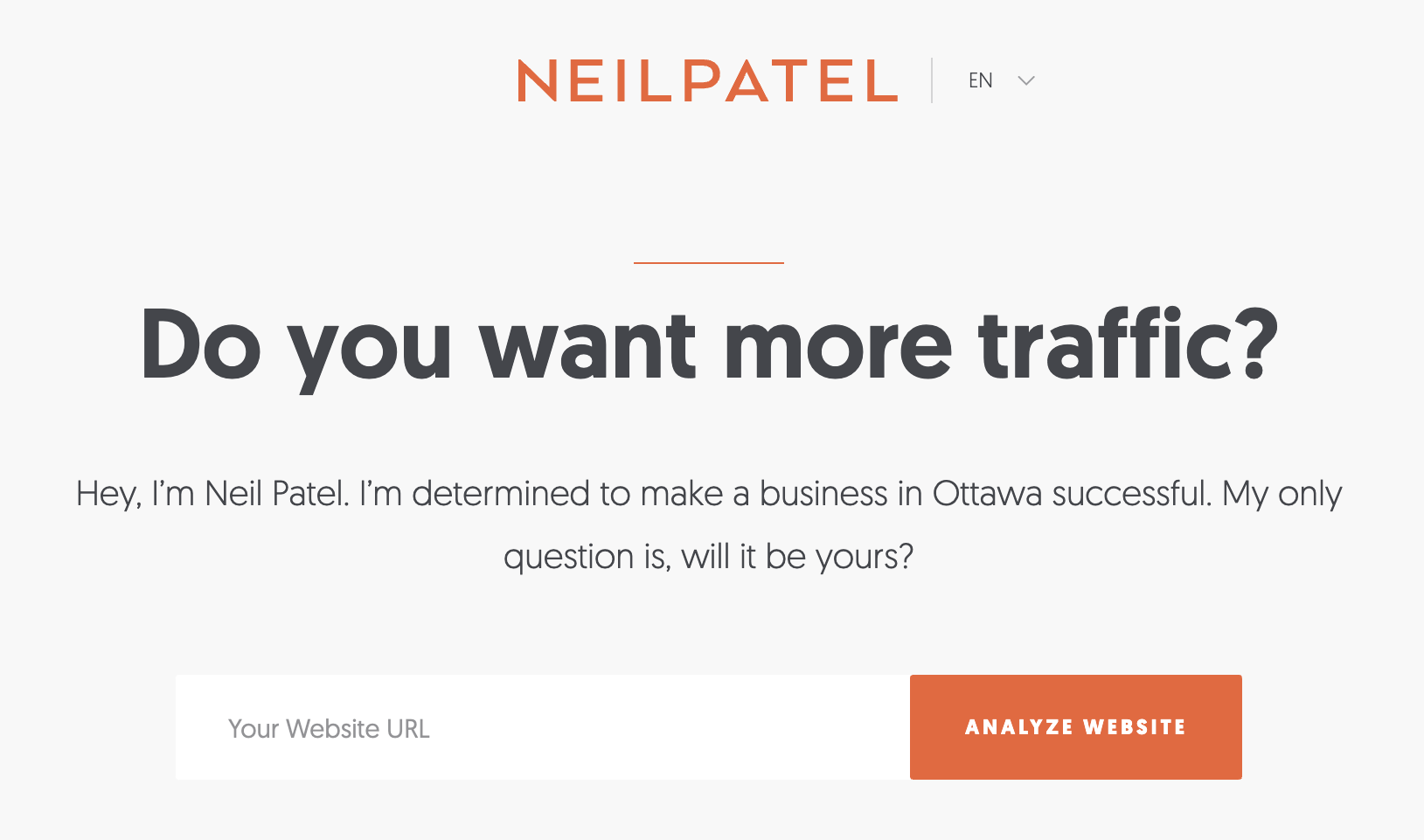
He also offers users valuable information and tools to get them started on their marketing journey. It’s only after a few clicks you see the call-to-action to sign up to grow your traffic:
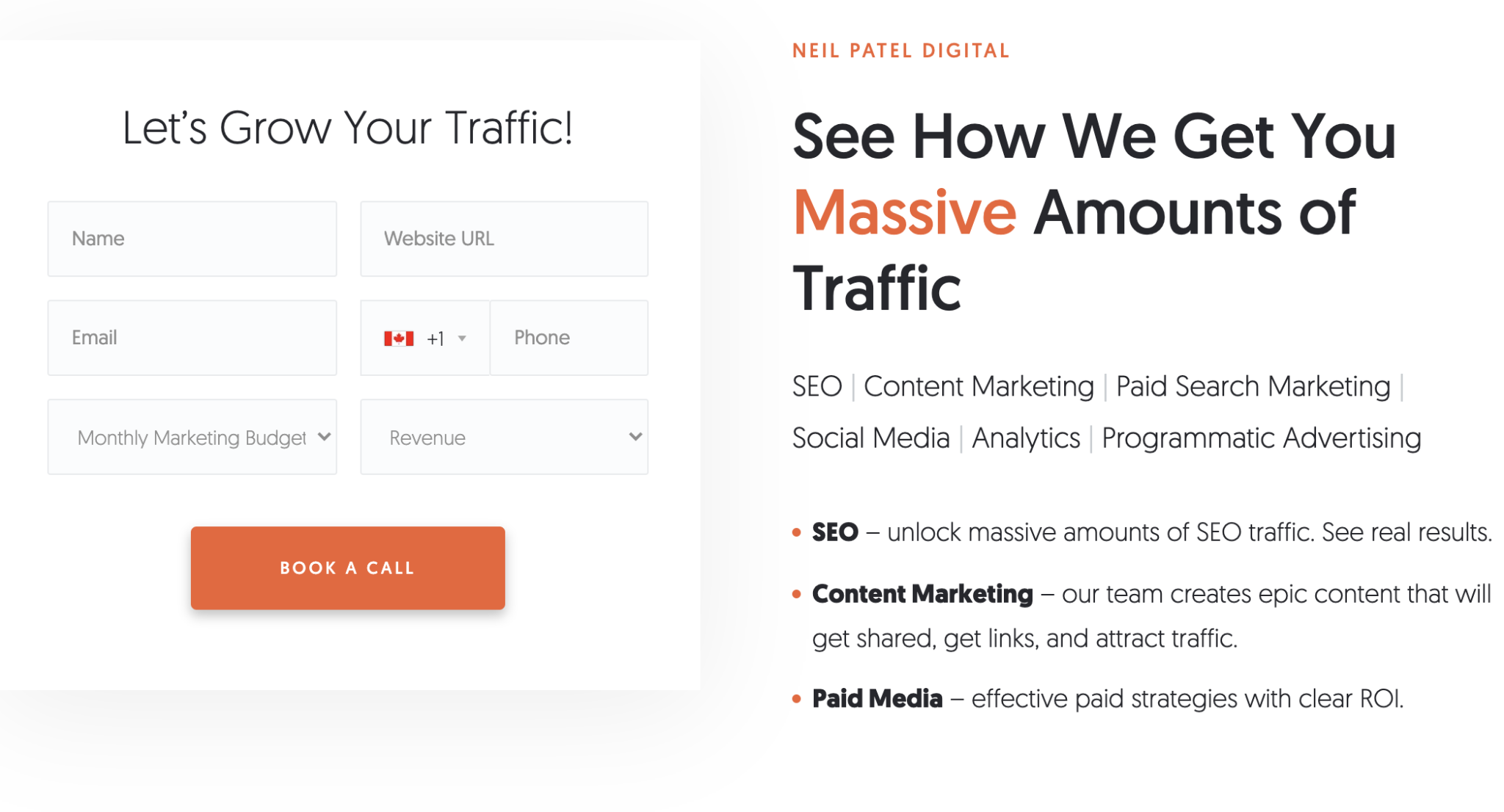
By first using his tools and reading his resources, the consumer starts to feel like a client and is more likely to commit to more (like purchasing the consulting service offered above) when the time is right.
5. Liking: We like people who are similar, who give us compliments and who cooperate with us.
People can be easily persuaded by other people that they like. Physically attractive people are shown to be more persuasive and are seen as more kind or intelligent (this is called the halo effect). This principle can be applied to increase conversions from your website by creating a great “About Us” page or using smiling headshots as your images. Since similarity is a key building block of liking, an effective “About Us” page is vital. The more similar or familiar you seem to the user, the more they will like you.
Blake Suarez is a designer and illustrator who has one of the most endearing ‘about’ pages I’ve come across in a while. He gives off a fun, goofy vibe and I can relate to his mention of working alongside dogs and plants. People have an innate desire to connect to others, and if you come across as genuine, they will notice.

6. Consensus: If others (especially others who are similar to you) are doing it, then we are more likely to do it too.
Also known as social proof, consensus is the reason why google reviews are so coveted, why “likes” are bought and faked and why social media is obsessed with follower counts. “If a lot of other people like it, then it must be good”.
Another good example of social proof is how social networks will show you who of your friends also like a page, or if they’re going to an event. We tend to follow the lead of other people, particularly when we’re unsure of what to do. Social proof increases with the numbers and credibility of people; when more people are doing something, we’re more inclined to do it ourselves.
This is particularly evident in TikTok when you look at trending videos and dances. The terrifying Asch conformity experiments prove how easily people are manipulated by a majority group.
One of the most powerful ways to use social proof is through so-called “wisdom-of-the-crowds.” Take Etsy for example. Their product pages include not just reviews, but also a counter that tallies the number of sales. You’ll see this in most popular e-commerce stores like ThredUp, eBay, and Sephora. The more an item is perceived to be liked by others, the more we want it too!
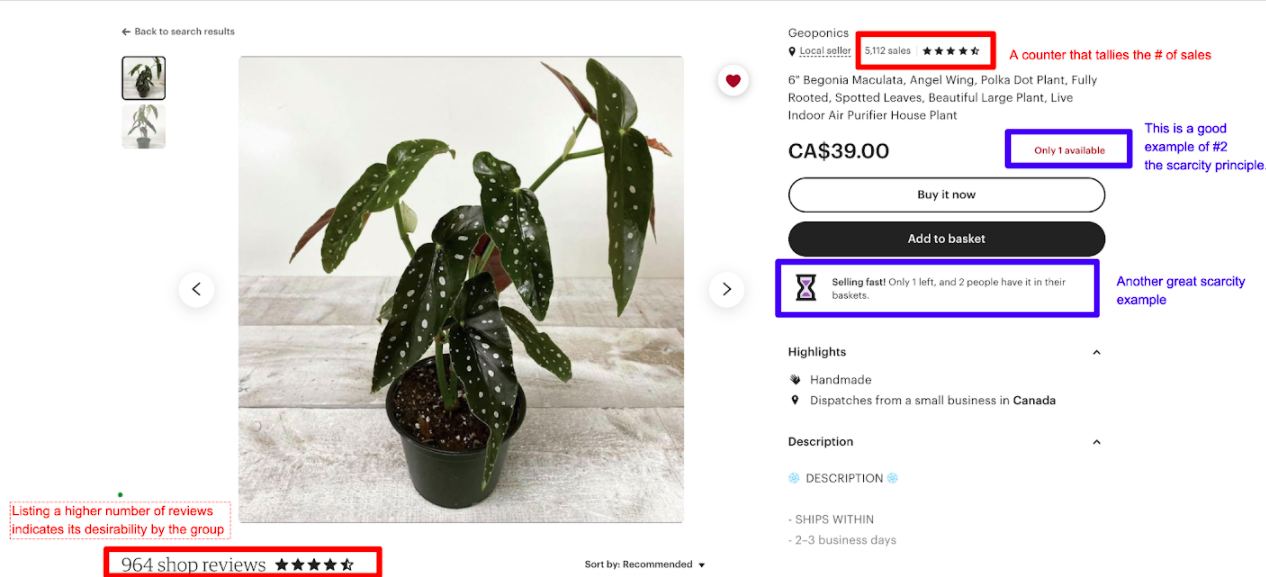
The six principles of persuasion in context: selling carpooling to university students
Now that we’ve gone through these six tactics in detail, here’s a quick analogy to show how they can be applied to make a sale.
Let’s say I worked at a university and I wanted to develop a strategy to increase carpooling on campus. Here is how I would use each of these principles to try and influence the student’s carpooling behaviour and increase its desirability:
- Reciprocity: advertise that parking passes are priced low and will stay low the following year if more people carpool.
- Scarcity: provide a limited number of special parking spaces for those who carpool.
- Authority: have the university president or famous alumni make an announcement about the benefits of carpooling.
- Consistency: Using the foot-in-the-door technique — first ask them to carpool only once a month, then ask for more later.
- Liking: emphasize that it’s an environmentally friendly initiative, to make it appear as the morally superior choice.
- Consensus: implement social validation by giving stickers to put on cars, to indicate that they are carpoolers
How you can apply these principles online
1. Reciprocity
- Provide free samples to users
- If you’re a service-based business, provide a free trial for new users
- Add a free gift or a handwritten note when people order something from you
- Provide access to useful white papers for free, or provide relevant and useful information that your users would find valuable.
- Blog about actionable and practical information that your customers would find helpful, your blog makes site visitors more likely to feel obligated to buy something from your site, providing you with an eventual conversion.
2. Scarcity:
- If you run an online store, indicate the amount of stock left for a particular item
- Use a sign-up form when an item is out of stock so that users can be notified when the item is available again
- If you’re selling a service or product online, use a countdown to indicate that their time is running out to complete the sign-up process,
- If you sell online, have a one-day sale, but advertise to your loyal customers first through email
3. Authority:
- The principle of Authority works not only for celebrities endorsing products but also for websites; if you want users to take your content and product seriously, ensure that your website looks trustworthy, up-to-date and relevant to your business. This means no spelling mistakes, following best practices, and making sure your website is accessible
- If part of your marketing plan includes using social media, consider researching the influencers or those that have authority in your space, and start a conversation. Most professional “influencers” require a big fee to get started, but there are a lot of micro-influencers that will work with smaller companies if their brand is in line with yours.
4. Consistency:
- By getting site visitors to commit to something relatively small (and usually free), like a guide or whitepaper, it increases the likelihood that those site visitors will eventually see themselves as customers. That change in self-perception makes it easier to follow up with an offer for a paid product or service. (This is similar to the “foot in the door” technique.)
- Provide no commitment obligations, shorter-term contracts or flexible payment options so that while the user does not have to fully commit at this time, they will feel indebted to commit at a later time.
- Providing free trials or products at the beginning of the relationship will also increase the likelihood that this user will later commit to your business.
5. Liking:
- Write an interesting and relatable about us page on your website
- Smile in photos that you use online or in your marketing assets; people are naturally drawn to happy people.
- Use warm and friendly language (business permitting) across your website. Remember to write specifically for the web: simple and concise language works best. If you use complicated vocabulary or too many words, the user will feel alienated and will be less likely to keep reading.
6. Consensus:
- Add testimonials to your website for “social proof”
- Ask your clients to leave Google reviews
- If you run an e-commerce store, add the heart or like feature (with a counter) so that users can see how popular a product or service may be.
- Grow your social media following with a comprehensive social media plan, and engage with those followers on a regular basis.
The six principles I’ve outlined in this article have been used by marketers, personal coaches and major brands for over 35 years, but it’s only in the last five years that digital psychology has been made accessible to small businesses and entrepreneurs online.
These principles work just as well for yourself and your personal development as they do for your online business. Likability, consistency, and reciprocity are all seen as desirable traits by others, and cult classics like “How to Make Friends and Influence People” by Dale Carnegie, written in 1936, touched upon these very same concepts.
If you’re curious about how we use the authority principle in our own work, check out what our Strategist Wendy wrote on how website redesigns can affect your business.
Do you need help improving your online presence, or gaining a better understanding of how to reach your target audience? Let’s get on a FREE consultation call today.
Let's chat about your goals
OR tell us more about you
Swipe up for expert help!
